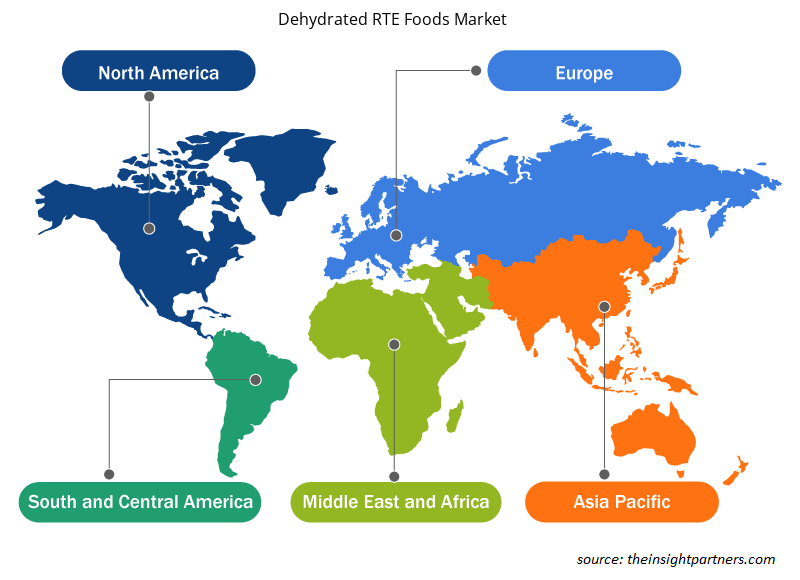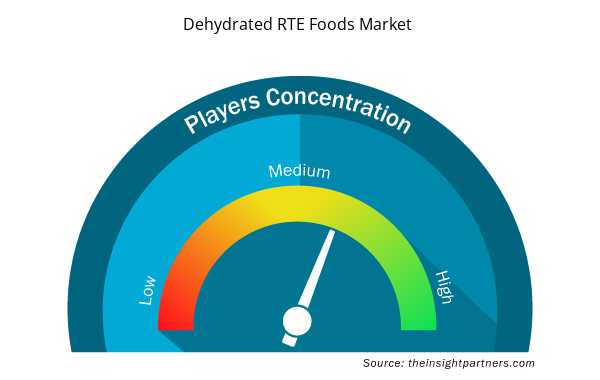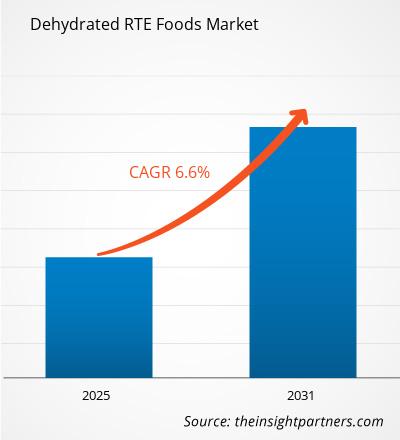Le marché des aliments RTE déshydratés devrait enregistrer un TCAC de 6,55 % de 2025 à 2031, avec une taille de marché passant de XX millions USD en 2024 à XX millions USD d'ici 2031.
Le rapport sur le marché des aliments prêts à consommer déshydratés présente une analyse approfondie classée par type de produit, canal de distribution et région. Il comprend une répartition régionale mettant en évidence les principaux marchés et pays, offrant ainsi une perspective mondiale. Les évaluations de marché sont présentées en dollars américains ($US), ce qui facilite une compréhension approfondie de la dynamique du marché, des tendances de croissance et de la concurrence sur les différents segments. Ces informations aident les acteurs à identifier les opportunités et à prendre des décisions éclairées sur le marché en pleine expansion des aliments prêts à consommer déshydratés.
Objet du rapport
Le rapport sur le marché des aliments prêts à consommer déshydratés, publié par The Insight Partners, vise à décrire le paysage actuel et la croissance future, les principaux moteurs, les défis et les opportunités. Il fournira des informations aux différents acteurs du secteur, notamment :
- Fournisseurs/fabricants de technologies : pour comprendre l’évolution de la dynamique du marché et connaître les opportunités de croissance potentielles, leur permettant de prendre des décisions stratégiques éclairées.
- Investisseurs : réaliser une analyse complète des tendances concernant le taux de croissance du marché, les projections financières du marché et les opportunités qui existent tout au long de la chaîne de valeur.
- Organismes de réglementation : Réglementer les politiques et les activités de police sur le marché dans le but de minimiser les abus, de préserver la confiance des investisseurs et de maintenir l’intégrité et la stabilité du marché.
Segmentation du marché des aliments prêts à consommer déshydratés
Taper
- En conserve
- Congelé/Réfrigéré
Canal de distribution
- Supermarchés et hypermarchés
- Dépanneurs
- Vente au détail en ligne
Personnalisez ce rapport en fonction de vos besoins
Vous bénéficierez d'une personnalisation gratuite de n'importe quel rapport, y compris des parties de ce rapport, ou d'une analyse au niveau des pays, d'un pack de données Excel, ainsi que de superbes offres et réductions pour les start-ups et les universités.
Marché des aliments prêts à consommer déshydratés : perspectives stratégiques

- Obtenez les principales tendances clés du marché de ce rapport.Cet échantillon GRATUIT comprendra une analyse de données, allant des tendances du marché aux estimations et prévisions.
Facteurs de croissance du marché des aliments prêts à consommer déshydratés
- Demande croissante de repas rapides et faciles : La demande croissante des consommateurs pressés pour des repas pratiques a fait exploser la popularité des plats prêts à consommer. Face à la hausse des horaires de travail, le besoin de repas rapides et faciles est devenu primordial.
- Augmentation des activités de plein air : l'essor des activités de plein air et des voyages a accru la demande d'aliments prêts à consommer, légers et peu périssables. Un autre moteur clé de la croissance du marché des aliments prêts à consommer déshydratés est la sensibilisation croissante aux questions de santé et de nutrition, qui incite les consommateurs à rechercher des alternatives plus saines et sans conservateurs.
- Proposer des options végétales : Une tendance émergente dans ce secteur est que les options végétales sont de plus en plus recherchées. De nombreuses entreprises lancent des aliments déshydratés prêts à consommer à base de fruits, de légumes et de légumineuses. De plus, la croissance des sites de commerce électronique a accru leur disponibilité à tel point que chaque client peut facilement découvrir de nombreuses options parmi ces produits.
Tendances futures du marché des aliments prêts à consommer déshydratés
- Saveurs et formulations créatives : De plus en plus, les consommateurs recherchent des expériences gustatives particulières ; cela a poussé les propriétaires de marques à expérimenter avec des ingrédients exotiques et des aliments provenant d'autres cuisines mondialement connues.
- Durabilité des aliments fonctionnels : La durabilité devient un enjeu majeur, et les entreprises s'efforcent d'utiliser des emballages et des approvisionnements plus écologiques. Une autre tendance en plein essor est celle des aliments fonctionnels ; les consommateurs recherchent des bienfaits pour la santé dans les aliments prêts à consommer, comme les aliments enrichis en nutriments ou les probiotiques.
- Pénétration des réseaux sociaux : la pénétration des réseaux sociaux dans les tendances alimentaires incite les marques à créer des produits attrayants pour le consommateur virtuel. Cette exigence de transparence dans l'approvisionnement des ingrédients incite les entreprises à divulguer l'origine et la valeur nutritionnelle des produits, ce qui séduit le consommateur averti.
Opportunités de marché pour les aliments prêts à consommer déshydratés
- Développement de produits nutritifs : Le marché des aliments prêts à consommer déshydratés offre de nombreuses perspectives de croissance et de développement. Tout d'abord, avec l'essor d'une alimentation saine, le développement de produits riches en nutriments et adaptés à différents besoins alimentaires, tels que les régimes sans gluten, cétogènes ou végétaliens, restera une demande constante.
- Possibilités des marchés émergents : Là encore, les possibilités de croissance dans les marchés émergents sont immenses, principalement tirées par l’évolution du mode de vie et l’amélioration du revenu disponible.
- Collaborations stratégiques : des collaborations avec des chefs et des experts permettront de développer des offres adaptées aux goûts des gourmets. Enfin, les kits repas par abonnement élargissent le marché des aliments prêts à consommer déshydratés en proposant des expériences culinaires personnalisées, privilégiant praticité et saveur.
Aperçu régional du marché des aliments prêts à consommer déshydratés
Les tendances et facteurs régionaux influençant le marché des aliments prêts à consommer déshydratés tout au long de la période de prévision ont été analysés en détail par les analystes d'Insight Partners. Cette section aborde également les segments et la géographie du marché des aliments prêts à consommer déshydratés en Amérique du Nord, en Europe, en Asie-Pacifique, au Moyen-Orient et en Afrique, ainsi qu'en Amérique du Sud et en Amérique centrale.

- Obtenez les données régionales spécifiques au marché des aliments prêts à consommer déshydratés
Portée du rapport sur le marché des aliments prêts à consommer déshydratés
| Attribut de rapport | Détails |
|---|---|
| Taille du marché en 2024 | XX millions de dollars américains |
| Taille du marché d'ici 2031 | XX millions de dollars américains |
| TCAC mondial (2025 - 2031) | 6,55% |
| Données historiques | 2021-2023 |
| Période de prévision | 2025-2031 |
| Segments couverts | Par type
|
| Régions et pays couverts | Amérique du Nord
|
| Leaders du marché et profils d'entreprises clés |
|
Densité des acteurs du marché des aliments prêts à consommer déshydratés : comprendre son impact sur la dynamique commerciale
Le marché des aliments prêts à consommer déshydratés connaît une croissance rapide, portée par une demande croissante des consommateurs, notamment en raison de l'évolution des préférences des consommateurs, des avancées technologiques et d'une meilleure connaissance des avantages du produit. Face à cette demande croissante, les entreprises élargissent leur offre, innovent pour répondre aux besoins des consommateurs et capitalisent sur les nouvelles tendances, ce qui alimente la croissance du marché.
La densité des acteurs du marché désigne la répartition des entreprises opérant sur un marché ou un secteur particulier. Elle indique le nombre de concurrents (acteurs) présents sur un marché donné par rapport à sa taille ou à sa valeur marchande totale.
Les principales entreprises opérant sur le marché des aliments RTE déshydratés sont :
- Soupe Campbell
- ConAgra
- General Mills
- Groupe Greencore
- Kraft Heinz
Avertissement : Les entreprises répertoriées ci-dessus ne sont pas classées dans un ordre particulier.

- Obtenez un aperçu des principaux acteurs du marché des aliments déshydratés prêts à consommer
Principaux arguments de vente
- Couverture complète : Le rapport couvre de manière exhaustive l'analyse des produits, des services, des types et des utilisateurs finaux du marché des aliments RTE déshydratés, offrant un paysage holistique.
- Analyse d’experts : Le rapport est compilé sur la base d’une compréhension approfondie des experts et analystes du secteur.
- Informations à jour : Le rapport garantit la pertinence commerciale en raison de sa couverture des informations récentes et des tendances des données.
- Options de personnalisation : ce rapport peut être personnalisé pour répondre aux exigences spécifiques des clients et s'adapter de manière appropriée aux stratégies commerciales.
Le rapport de recherche sur le marché des aliments prêts à consommer déshydratés peut donc contribuer à éclairer et à comprendre le contexte et les perspectives de croissance du secteur. Malgré quelques inquiétudes légitimes, les avantages globaux de ce rapport tendent à l'emporter sur ses inconvénients.
- Analyse historique (2 ans), année de base, prévision (7 ans) avec TCAC
- Analyse PEST et SWO
- Taille du marché Valeur / Volume - Mondial, Régional, Pays
- Industrie et paysage concurrentiel
- Ensemble de données Excel



Report Coverage
Revenue forecast, Company Analysis, Industry landscape, Growth factors, and Trends

Segment Covered
This text is related
to segments covered.

Regional Scope
North America, Europe, Asia Pacific, Middle East & Africa, South & Central America

Country Scope
This text is related
to country scope.
Questions fréquemment posées
Some of the customization options available based on request are additional 3-5 company profiles and country-specific analysis of 3-5 countries of your choice. Customizations are to be requested/discussed before making final order confirmation, as our team would review the same and check the feasibility.
Key players in this market are - Campbell Soup, ConAgra, General Mills, Greencore Group, Kraft Heinz, McCain Foods Limited, Nestle, Sigma Alimentos, The Schwan Food
The market is expected to register a CAGR of 6.55% during 2023-2031
The driving forces of the dehydrated RTE foods market include increasing demand for convenient meal solutions by the consumer, popularity of outdoor activities, growing health awareness, and trends toward plant-based options, coupled with accessibility through e-commerce platforms.
Future trends in the dehydrated RTE foods market are toward uniqueness of flavor, eco-friendliness, functionality, aesthetic appeal runway social media, and transparency in ingredient sourcing, since consumers increasingly tend to be health-conscious and gourmet food appearance-oriented.
The report can be delivered in PDF/PPT format; we can also share excel dataset based on the request.
Trends and growth analysis reports related to Food and Beverages : READ MORE..
1. Campbell Soup
2. ConAgra
3. General Mills
4. Greencore Group
5. Kraft Heinz
6. McCain Foods Limited
7. Nestle
8. Sigma Alimentos
9. The Schwan Food
10. Unilever
The Insight Partners performs research in 4 major stages: Data Collection & Secondary Research, Primary Research, Data Analysis and Data Triangulation & Final Review.
- Data Collection and Secondary Research:
As a market research and consulting firm operating from a decade, we have published and advised several client across the globe. First step for any study will start with an assessment of currently available data and insights from existing reports. Further, historical and current market information is collected from Investor Presentations, Annual Reports, SEC Filings, etc., and other information related to company’s performance and market positioning are gathered from Paid Databases (Factiva, Hoovers, and Reuters) and various other publications available in public domain.
Several associations trade associates, technical forums, institutes, societies and organization are accessed to gain technical as well as market related insights through their publications such as research papers, blogs and press releases related to the studies are referred to get cues about the market. Further, white papers, journals, magazines, and other news articles published in last 3 years are scrutinized and analyzed to understand the current market trends.
- Primary Research:
The primarily interview analysis comprise of data obtained from industry participants interview and answers to survey questions gathered by in-house primary team.
For primary research, interviews are conducted with industry experts/CEOs/Marketing Managers/VPs/Subject Matter Experts from both demand and supply side to get a 360-degree view of the market. The primary team conducts several interviews based on the complexity of the markets to understand the various market trends and dynamics which makes research more credible and precise.
A typical research interview fulfils the following functions:
- Provides first-hand information on the market size, market trends, growth trends, competitive landscape, and outlook
- Validates and strengthens in-house secondary research findings
- Develops the analysis team’s expertise and market understanding
Primary research involves email interactions and telephone interviews for each market, category, segment, and sub-segment across geographies. The participants who typically take part in such a process include, but are not limited to:
- Industry participants: VPs, business development managers, market intelligence managers and national sales managers
- Outside experts: Valuation experts, research analysts and key opinion leaders specializing in the electronics and semiconductor industry.
Below is the breakup of our primary respondents by company, designation, and region:

Once we receive the confirmation from primary research sources or primary respondents, we finalize the base year market estimation and forecast the data as per the macroeconomic and microeconomic factors assessed during data collection.
- Data Analysis:
Once data is validated through both secondary as well as primary respondents, we finalize the market estimations by hypothesis formulation and factor analysis at regional and country level.
- Macro-Economic Factor Analysis:
We analyse macroeconomic indicators such the gross domestic product (GDP), increase in the demand for goods and services across industries, technological advancement, regional economic growth, governmental policies, the influence of COVID-19, PEST analysis, and other aspects. This analysis aids in setting benchmarks for various nations/regions and approximating market splits. Additionally, the general trend of the aforementioned components aid in determining the market's development possibilities.
- Country Level Data:
Various factors that are especially aligned to the country are taken into account to determine the market size for a certain area and country, including the presence of vendors, such as headquarters and offices, the country's GDP, demand patterns, and industry growth. To comprehend the market dynamics for the nation, a number of growth variables, inhibitors, application areas, and current market trends are researched. The aforementioned elements aid in determining the country's overall market's growth potential.
- Company Profile:
The “Table of Contents” is formulated by listing and analyzing more than 25 - 30 companies operating in the market ecosystem across geographies. However, we profile only 10 companies as a standard practice in our syndicate reports. These 10 companies comprise leading, emerging, and regional players. Nonetheless, our analysis is not restricted to the 10 listed companies, we also analyze other companies present in the market to develop a holistic view and understand the prevailing trends. The “Company Profiles” section in the report covers key facts, business description, products & services, financial information, SWOT analysis, and key developments. The financial information presented is extracted from the annual reports and official documents of the publicly listed companies. Upon collecting the information for the sections of respective companies, we verify them via various primary sources and then compile the data in respective company profiles. The company level information helps us in deriving the base number as well as in forecasting the market size.
- Developing Base Number:
Aggregation of sales statistics (2020-2022) and macro-economic factor, and other secondary and primary research insights are utilized to arrive at base number and related market shares for 2022. The data gaps are identified in this step and relevant market data is analyzed, collected from paid primary interviews or databases. On finalizing the base year market size, forecasts are developed on the basis of macro-economic, industry and market growth factors and company level analysis.
- Data Triangulation and Final Review:
The market findings and base year market size calculations are validated from supply as well as demand side. Demand side validations are based on macro-economic factor analysis and benchmarks for respective regions and countries. In case of supply side validations, revenues of major companies are estimated (in case not available) based on industry benchmark, approximate number of employees, product portfolio, and primary interviews revenues are gathered. Further revenue from target product/service segment is assessed to avoid overshooting of market statistics. In case of heavy deviations between supply and demand side values, all thes steps are repeated to achieve synchronization.
We follow an iterative model, wherein we share our research findings with Subject Matter Experts (SME’s) and Key Opinion Leaders (KOLs) until consensus view of the market is not formulated – this model negates any drastic deviation in the opinions of experts. Only validated and universally acceptable research findings are quoted in our reports.
We have important check points that we use to validate our research findings – which we call – data triangulation, where we validate the information, we generate from secondary sources with primary interviews and then we re-validate with our internal data bases and Subject matter experts. This comprehensive model enables us to deliver high quality, reliable data in shortest possible time.

 Obtenez un échantillon gratuit pour ce rapport
Obtenez un échantillon gratuit pour ce rapport